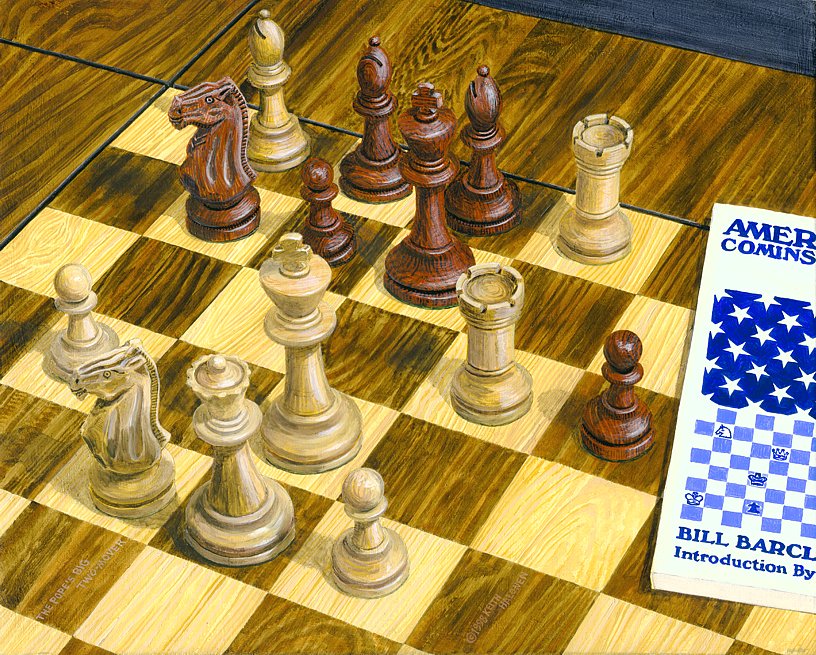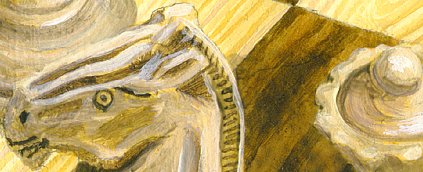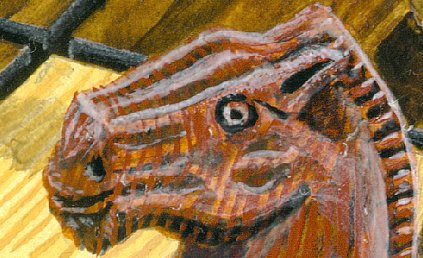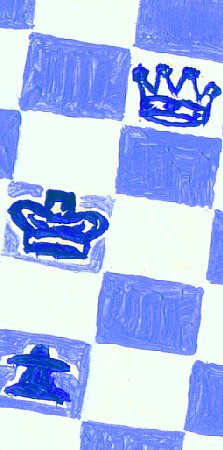|
|

|
|
THE POPE'S BIG TWO-MOVER
© 1998 Keith Halonen oil on panel 10×8 in / 25×20 cm $ 3,500 US |

|
« CLICK to contact the artist |





|
CLICK » to order this print |

|
|
YOU ARE IN THE CHESS PAINTINGS GALLERY
CLICK THE SHORTCUT ICONS ABOVE TO VIEW MORE PAINTINGS |
|
This problem is not really bigger than The Pope's Little Two-Mover. It involves more than seven pieces, though, and is therefore not a miniature — just more complicated. Still, it is a two-mover, meaning White and then Black each make a first move, after which White's second move must checkmate Black. The solver must find the correct first move, known as the key. If Black can escape mate after White's second move, the first move was incorrect and was not the real key. As with most problems, the square at upper left is a8. This problem was also attributed to Karol Wojtyla, better known as Pope John-Paul II. Inasmuch as there are known hoax problems attributed to Pope John-Paul, please don't hold me responsible if it should turn out that this problem was not really composed by the late pontiff.
Mathematicians Kasner and Newman estimate the number of possible distinct 40-move chess games (how many really end on move 40?) to be 25×10115. The estimated number of electrons in the universe is only 1079. In any chess game, after three moves by each player there are over 9,000,000 possible positions. By contrast, there are only 6 different types of pieces and only about 16 different categories of middlegame interactions between the pieces. Why then should anyone study chess problems if the likelihood of actually encountering any specific position is so remote? Solvers gain an intangible but very real working knowledge of the dynamic interactions between pieces. To put it in common terms, they are getting to know the lay of the land. Solvers do not expect to find themselves in any particular position they have studied, but they do expect to deal with very similar situations often enough for their studies to prove valuable. Problem solving produces and refines a subconscious skill players refer to as sight of board. There have probably been over 45,000 distinct books published about chess. The solution to this problem can be found in the book depicted in the painting, Bill Barclay's America Salutes Comins Mansfield, M.B.E., Chess Enterprises 1983. |
 
|

|
|
|
Detail from THE POPE'S LITTLE TWO-MOVER
|
|
To give some idea of the detail in the original 10 × 8 inch (25 × 20 cm) painting, the tiny blue squares on the book cover are ¼-inch (6.5 mm) across. The dark knight's head is one inch (2.5 cm) from nose to mane.
The knight is the only piece that bears a realistic semblance to the thing it symbolizes, a mounted soldier. The most familiar piece shapes were designed by early 19th century artist Nathaniel Cook, who patented them in March 1849. His knight pattern was inspired by the Parthenon Frieze in the Elgin Marbles. Chess originated in India and Persia during the 5th century. It is a war game and the pieces are derivative of the divisions in the Indian army of that era. The modern names of the pieces reflect the arrival of the game in European countries around the year 1000. Originally, the pawn was an infantry soldier, the knight a mounted warrior. The bishop's shape is thought to represent a miter, the liturgical headwear of a bishop. It's actually the tusk of the Indian army elephant, with a ball affixed onto the tip and with the mouth of the beast symbolized by the slot. The rook derives its name from the ancient Sanskrit word rukh, meaning chariot. There was no queen in the Indian army; but rather a vizier, an advisor or general. Finally, in Sanskrit the king is shah and we still speak that ancient tongue when we say "check" or "checkmate." We are actually saying shah and shah mat, meaning the king is under attack or hopelessly trapped. |
———————— GALLERIES ————————









|